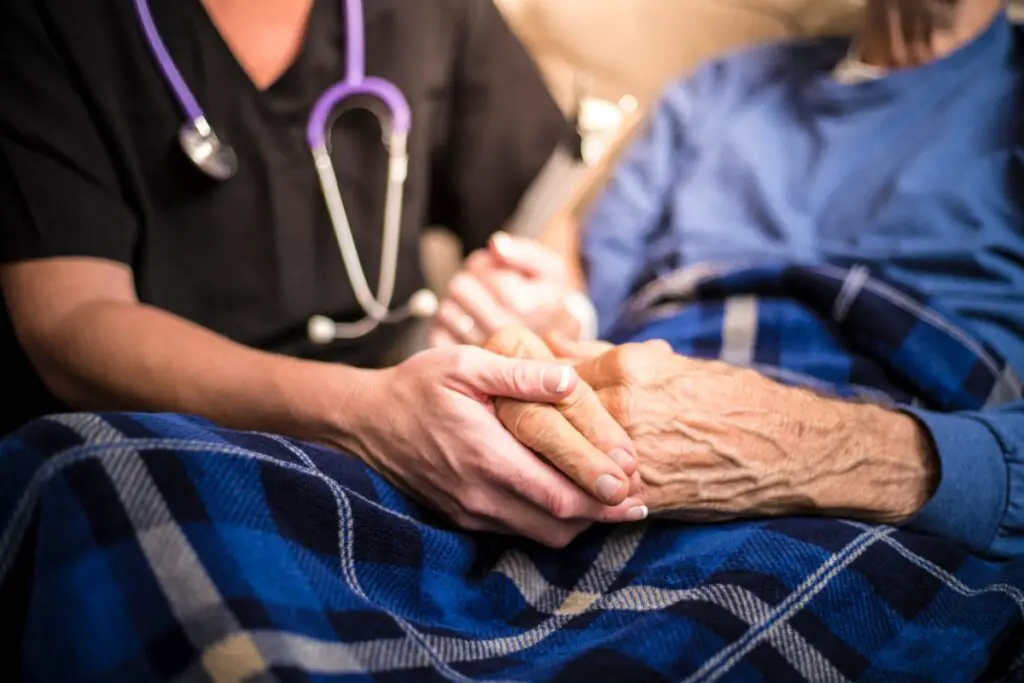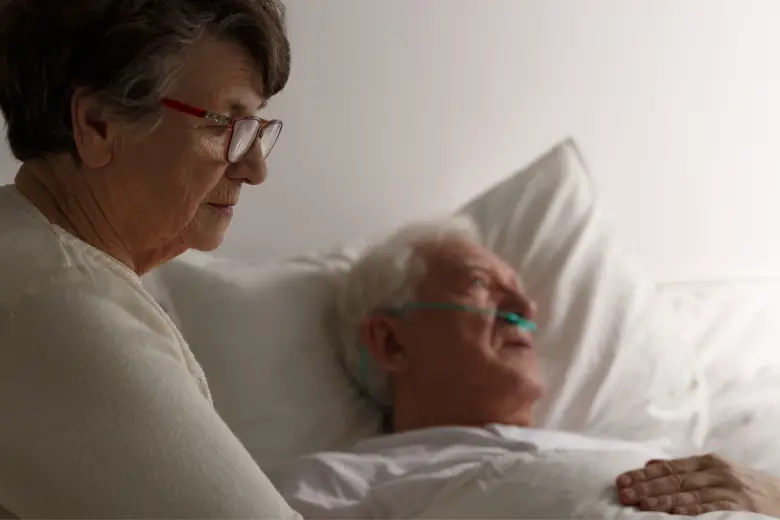Hospice care is a valuable but misunderstood medical and comfort care for patients and their families at the end of life. Working with the dying can lead to interesting experiences. In some cases, there are what are collectively called “hospice nurse unexplained phenomena.”
Hospice 101
You must have a terminal diagnosis with a life expectancy of 6 months or less verified with a doctor’s order to qualify for hospice. Once hospice services are initiated, an interdisciplinary team of hospice professionals address the patient’s physical, emotional, and spiritual needs while managing pain.
Since hospice deals with dying, it is understandable that some patients and their families are reluctant to choose hospice. Facing death can be a mix of fear, trauma, comfort, and anxiety about what will happen as a loved one dies.
The hospice nurse guides care, requests pain medications, orders additional services and durable medical equipment, and reports to the medical director. But more importantly, the hospice nurse is the person who comforts families and patients and walks with families as they struggle to understand and accept death. Hospice nurses have seen hundreds of people die, and they have an idea of when death is imminent and can recognize the signs of a surge before death and other unexplained phenomena.
Can a Hospice Nurse Tell When Death is Near?
Death and dying are a mystery, but a hospice nurse can recognize when death is near. However, there are always things that hospice cannot tell you. A patient could exhibit signs of dying but go on living for weeks or even months. What is it about hospice nurses that give them the ability to tell when death is near?
- Hospice nurses visit the patient and family several times a week, usually about three times a week in the beginning. As someone starts to decline, the hospice nurse may come more often.
- Hospice nurses assess physiological and emotional signs when they visit the patient. A nurse will check oxygen levels, blood pressure, eating and drinking habits, wakefulness, and cognition. They will also talk with the family for additional details about any changes.
- Hospice nurses value the dying person’s experience and listen to what they have to say. Even if someone can’t express that death is near, they probably know it.
- Hospice nurses work with a team. The team includes social workers, aides, a chaplain, music, art, pet therapists, and volunteers. These individuals aim to relieve suffering and provide comfort and spiritual guidance. Each team member reports to the hospice nurse and gives their impressions and suggestions for care.
Hospice Nurse Unexplained Phenomena
The most common and perplexing unexplained phenomena before death are a rally, surge, or terminal lucidity. All of these terms describe the same experience of a period of wakefulness and clarity that can predict death. This is often what’s referred to as hospice nurse unexplained phenomena.
People often view hospice nurses as the point person who arranges care and coordinates a plan with the medical director. And although these functions are important, the hospice nurse plays a crucial role in comforting the dying person and their family when unexplained phenomena such as a surge occur.
- The hospice nurse brings a calm and compassionate presence to the dying individual and the family. Emotions can run high when someone you care about is dying, and those emotions are not always pleasant or easy to cope with.
- When strange and unexplained phenomena occur, it is natural to feel upset and anxious. Your loved one may appear to be suffering and in great discomfort. The hospice nurse puts these phenomena in the context of the dying experience and can intercede with medications or other comfort measures.
- One of the challenges when someone is dying is how to inform family who may be far away. If someone has weeks or months to live, it may not be practical for family or friends to travel a great distance to be with a dying loved one. Hospice nurses do their best to predict when a good time to come will be.
We think of unexplained phenomena as affecting the dying person, but the family experiences unique emotions that can be unsettling and strange. For example, some people go into a kind of shock reaction. A shock reaction is more likely for families who have not been with their loved one during the process of dying and haven’t seen the person in a while.
The other phenomenon that can be upsetting is feelings of anger or resentment. Unresolved issues with your parent or other loved one can emerge during this time. Feelings of grief and loss before your loved one dies can be overwhelming and confusing.
There could also be family discord or disagreement about hospice. It is not unusual for this conflict to continue even though hospice is already initiated.
Hospice nurses have seen it all. They are skilled at helping bring people together and normalizing disturbing ranges of emotion. The goal is to support the dying person, and the hospice nurse gently brings everyone to this awareness.
What is the Surge Before Death?
The surge before death, sometimes called terminal lucidity, is an increase in energy minutes, hours, or days before a person dies. When someone is dying, they may stop eating, drinking, and sleep most of the time. There could be very little communication with family. Here are some of the characteristics of a surge before death:
- A sudden surge of energy and wakefulness
- A desire to eat after refusing food; occasionally, someone might ask for unusual foods
- A need to communicate with people
- A clear mental state with improvement in cognition and memory
- Less pain and discomfort
- Conversations about travel or making plans
- A more cheerful attitude
- Recognizing family and friends
When a surge occurs, families often interpret these signs as their loved one improving. In most cases, this is not true. The hospice nurse can educate the family about what appears, but is not, an indication that someone will continue to get better.
What Happens Right Before Death?
There is no uniform way of dying. Much depends on someone’s diagnosis, their environment, and the medications they are on. However, common changes occur for most during the dying process, and you can expect to observe these symptoms:
Less Energy
The dying person has less energy and doesn’t move as much. They may sleep most of the time and have little desire to get up or engage.
Loss of Interest in Surroundings
There is a continuing lack of interest in talking with others or noticing surroundings. The dying person detaches from the environment. You should assume that your loved one can hear and understand what you are saying, even if they can’t communicate.
Diminished Desire for Drinking and Eating
The loss of interest in drinking and eating can be upsetting to families. This is normal; you should avoid pushing your loved one to eat or drink. You can offer, but if they don’t have any desire, then accept that.
Incontinence
Loss of bowel and bladder function is normal. Adult diapers or a catheter may become necessary at some point, especially if your loved one cannot reach the bathroom.
Body Temperature Changes
The person’s skin may be cold to the touch, or there could be an increase in body temperature.
Heart Rate, Blood Pressure, and Breathing Decrease
Near the end of life, almost all vital signs become erratic. Blood pressure and heart rate can fluctuate. Breathing can become irregular.
Increase in Pain
An increase in pain is common and can be due to several factors. Progression of the disease, joint stiffness, skin breakdown, and organs starting to fail can cause discomfort and pain.
Agitation and Restlessness
No one knows why, but it is common for someone who is dying to have periods of restlessness or agitation. They may call out and have difficulty settling down. Sometimes anxiety can arise from a fear of death and the unknown.
Skin Changes Color
Several days or hours before death, skin changes to purple, pale, or grey and becomes mottled.
Hallucinations and Delusions
are when someone hears or sees things, pets, or people you can’t observe. Hallucinations may be disturbing, or they could be comforting. Delusions can be frightening if the person thinks others are trying to harm them. They may also think they are capable of tasks that they aren’t.
Near-Death Experiences
Near-death experiences involve talking about traveling or packing to go somewhere. Often people talk about religious or spiritual journeys or reunifying with people that have died before them.
How Long Does Terminal Lucidity Last Before Death?
Terminal lucidity can last for minutes, hours, or days. Most often, terminal lucidity occurs within a week or day of death, but there are documented cases of longer than that. About 90% of patients with dementia who exhibit terminal lucidity will die within seven days.
Terminal lucidity is a brief window to connect with someone who is dying. It is also an opportunity to notify other family members to come and pay their last respects. If you notice your loved one exhibiting terminal lucidity, notify the hospice nurse so they can anticipate that death could be near.
Hospice Nurses and the Dying Experience
Other than a spiritual leader, there may be no more skilled and experienced person than a hospice nurse when dealing with the journey of death. Their compassion and expertise can guide you, comfort you, and support you and your loved one through the inevitable unexplained phenomena of death.




